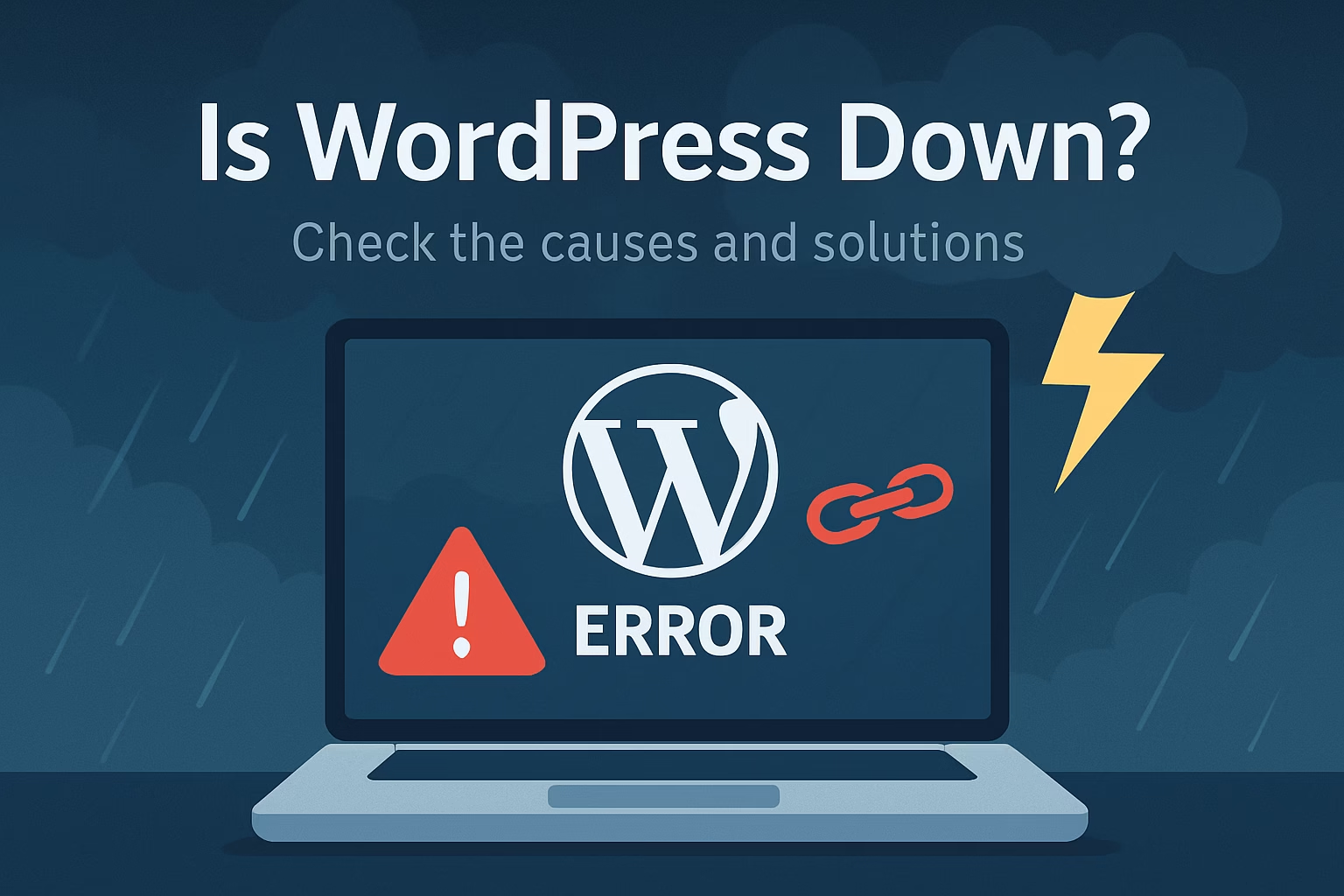You can use services like DownDetector, IsItDownRightNow, or Down for Everyone or Just Me to check if WordPress.com or your website is down for others too.
How to Know If WordPress Is Really Down
Sometimes your website may not load, but that doesn’t always mean WordPress is down. It could be a local issue, a problem with your hosting, or even a browser glitch. Here’s how to confidently find out whether it’s a WordPress-wide problem or something else.
Use Online Status Checker Tools
There are websites designed specifically to check if a popular service like WordPress is experiencing outages. Tools like:
These services collect reports from users around the world and show real-time data. If you see a spike in reported issues for WordPress, it’s likely a platform-wide problem. They often show a map of affected areas and a comment section where users share their experiences.
Check WordPress on Multiple Devices or Networks
Before assuming WordPress is down, test the website on another device or internet connection. For example:
- Try accessing WordPress on your phone using mobile data
- Use a different browser or a private/incognito window.
- Restart your router or try using a VPN.
If the site works on another device or network, the issue is probably with your internet connection, DNS, or local setup—not with WordPress itself.
Look for Outage Reports on Twitter or Reddit
Social media can be one of the fastest ways to know if a service like WordPress is down. Visit:
- Twitter/X and search for “WordPress down” or check hashtags like #WordPressDown.
- Reddit, especially subreddits like r/WordPress, where users often post real-time issues.
If many users are reporting problems around the same time, it likely confirms a widespread issue.
Common Reasons Why WordPress May Be Down
If you’ve confirmed that it’s not a global WordPress outage, the issue might be specific to your own website. Below are some of the most common reasons why your WordPress site might be down or inaccessible.
Server or Hosting Problems
Your website relies on a web host to stay online. If your hosting provider experiences server downtime, technical glitches, or DDoS attacks, your WordPress site may become temporarily unavailable.
Common hosting issues include:
- Server overload due to high traffic.
- Hardware failure or power outages in the data center.
- Expired hosting plans or suspended accounts due to non-payment.
Check your hosting provider’s status page or contact their support to see if there’s a known issue.
Plugin or Theme Conflicts
Incompatible or poorly coded plugins and themes can cause your site to crash or return a white screen (also known as the “white screen of death”).
Typical symptoms:
- Blank page on the frontend or backend.
- “500 Internal Server Error”.
- Dashboard inaccessible.
To fix this, disable all plugins via FTP or your hosting control panel, then reactivate them one by one to identify the problematic one. Similarly, switch to a default WordPress theme like Twenty Twenty-Four to rule out theme-related issues.
Domain or SSL Certificate Issues
If your domain has expired or your SSL certificate is invalid, browsers may block access to your site or display warnings like:
- “Your connection is not private”
- “This site can’t provide a secure connection”
Check:
- That your domain registration is active and not expired.
- Your SSL certificate status through tools like SSL Checker.
- That your DNS settings are correctly configured.
Renewing your domain or re-installing the SSL certificate often resolves the issue.
Scheduled Maintenance or WordPress Updates
WordPress may briefly display a message like “Briefly unavailable for scheduled maintenance” during updates. This usually disappears within a few seconds to minutes.
However, if the update process was interrupted, WordPress might remain stuck in maintenance mode.
To fix this:
- Connect to your site via FTP or file manager.
- Delete the .maintenance file located in the root directory.
What to Do If Your WordPress Site Is Not Working
When your WordPress site isn’t working properly, it can feel overwhelming. But don’t worry—there are practical steps you can take to diagnose and fix the problem quickly.
Troubleshoot Using Safe Mode or Disable Plugins
Many WordPress issues are caused by conflicting plugins or themes. To troubleshoot:
- Safe Mode: Some managed WordPress hosts or plugins offer a “Safe Mode” that temporarily disables plugins/themes to isolate problems. If you have access to this feature, activate it to see if your site loads correctly.
- Manually Disable Plugins: If Safe Mode isn’t available, you can disable plugins manually:
- Access your website files via FTP or your hosting file manager.
- Navigate to the /wp-content/plugins/ folder.
- Rename the plugins folder to something like plugins-disabled to deactivate all plugins.
- Check if the site loads. If yes, rename the folder back and reactivate plugins one by one from your WordPress dashboard to find the culprit.
- Switch Theme: Sometimes themes cause conflicts. Switch to a default WordPress theme like.
- Twenty Twenty-Four by renaming your current theme folder via FTP.
This step-by-step approach helps identify whether a plugin or theme is causing your issue.
Contact Your Web Hosting Provider
If plugin or theme troubleshooting doesn’t resolve the problem, the issue might be at the server level.
Your hosting provider can:
- Check for server outages or errors.
- Investigate if your site is being throttled due to high resource usage
- Help with database or server misconfigurations.
- Provide logs to pinpoint the problem.
Don’t hesitate to open a support ticket or live chat with your host—they have tools and access that can speed up diagnosing the issue.
Restore From a Backup (If Necessary)
If your site was working previously but now shows errors after recent changes or updates, restoring a backup is often the fastest way to recover.
- Many hosts provide automatic daily backups—ask your provider about restoration options.
- If you use plugins like UpdraftPlus, you can restore backups yourself via the WordPress dashboard.
- Ensure you backup your current site files and database before restoring, in case you need to recover anything later.
Regular backups are critical for minimizing downtime and data loss, so consider setting up scheduled backups if you haven’t already.
How to Stay Prepared for Future Downtime
While no website can be 100% immune to downtime, there are several proactive steps you can take to minimize the impact, detect issues faster, and recover quickly. Being prepared is the key to keeping your WordPress site reliable and your visitors happy.
Monitor Uptime With Tools Like UptimeRobot
Using a website monitoring tool helps you stay alert when your site goes offline—even for a few minutes.
One of the most popular tools is UptimeRobot. It checks your website at regular intervals (every 5 minutes or less) and alerts you via email, SMS, or even Slack when your site is down.
Other tools include:
- Pingdom
- StatusCake
- Jetpack Monitor (for WordPress users)
These tools also give you uptime reports and response times, helping you spot patterns and take action before issues become serious.
Keep Backups of Your WordPress Site
Backups are your safety net. If your site crashes due to a plugin update, server error, or even a hack, having a recent backup allows you to restore everything quickly.
Best practices:
- Use plugins like UpdraftPlus, BlogVault, or BackWPup to schedule automatic backups.
- Store backups offsite in services like Google Drive, Dropbox, or Amazon S3.
- Make sure to back up both your database and site files.
Your hosting provider may also offer daily or weekly backups—check their support options and consider enabling them if they’re not already active.
Update Plugins and Themes Regularly
Outdated plugins and themes are one of the most common causes of WordPress issues. They can lead to compatibility problems, slow performance, and even make your site vulnerable to security threats.
Tips for managing updates:
- Regularly check the Updates section in your WordPress dashboard.
- Enable automatic updates for trusted plugins and themes.
- Always back up your site before making major updates.
Also, remove any unused plugins or themes—they still pose a risk even if they’re inactive.
Conclusion
If you’ve ever asked yourself, “Is WordPress down?”, you now know how to find out quickly and take action. From checking online status tools to identifying common issues like hosting errors or plugin conflicts, you have the steps to troubleshoot and fix problems fast.
Staying prepared with backups, uptime monitoring, and regular updates ensures your site stays healthy long-term. WordPress issues are often temporary, but your preparation can make all the difference in keeping your site running smoothly.
Need help rebuilding your layout? Contact me and I’ll help you get your site back on track.
🔥 More WordPress & Website Health Posts That Go Hard:
- How to Fix WordPress Blank White Screen (White Screen of Death)
- Fix WordPress Site Preview Not Showing on Social Media (OG Tags Issue)
- Fix WordPress Not Sending Emails




